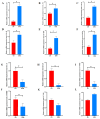Comparative Analysis of Short-Chain Fatty Acids and the Immune Barrier in Cecum of Dahe Pigs and Dahe Black Pigs
- PMID: 40218314
- PMCID: PMC11987949
- DOI: 10.3390/ani15070920
Comparative Analysis of Short-Chain Fatty Acids and the Immune Barrier in Cecum of Dahe Pigs and Dahe Black Pigs
Abstract
The intestinal immune barrier is a developed and complex immune system, and there is a fine synergy between it and the induced immune response. Short-chain fatty acids (SCFAs) are the main metabolites of intestinal microbial fermentation. In the cecum of pigs, SCFAs not only provide energy for the host but also participate in regulating the function of the intestinal immune system. The purpose of this study was to explore the mechanism of SCFAs in the regulation of immune gene expression in porcine cecum. SCFAs content and mRNA expression levels of immune genes in cecum were detected, and Gene Ontology (GO) function annotation, Kyoto Encyclopedia of Genes and Genomes (KEGG) pathway enrichment analysis, Protein-Protein Interaction Networks (PPI) network construction, key gene identification, and correlation analysis were performed. The results showed that the content of SCFAs in the cecum of Dahe black pigs (DHB) was lower than that of Dahe pigs (DH). There were significant differences in mRNA expression of some immune genes between the two groups. GO functional annotation found terms related to cytokine activity and protein heterodimerization activity; the KEGG pathway was enriched in several pathways related to intestinal immunity. The PPI network identified Interleukin-6 (IL-6), Interleukin-8 (IL-8), Interleukin-10 (IL-10), Interleukin-17A (IL-17A), and Interleukin-18 (IL-18) as key proteins. The correlation analysis showed that acetic acid and valerate were closely related to the immune response. In this study, the differences in cecal short-chain fatty acids and the immune barrier between Dahe pigs and Dahe black pigs were compared, which provided a theoretical basis for improving the intestinal immunity of pigs.
Keywords: cecum; immune barrier; immune genes; pigs; short-chain fatty acids.
Conflict of interest statement
All authors declare that they have no competing interests.
Figures







Similar articles
-
Single-nucleus transcriptome sequencing reveals hepatic cell atlas in pigs.BMC Genomics. 2023 Dec 12;24(1):770. doi: 10.1186/s12864-023-09765-9. BMC Genomics. 2023. PMID: 38087243 Free PMC article.
-
Increased Proportion of Fiber-Degrading Microbes and Enhanced Cecum Development Jointly Promote Host To Digest Appropriate High-Fiber Diets.mSystems. 2023 Feb 23;8(1):e0093722. doi: 10.1128/msystems.00937-22. Epub 2022 Dec 13. mSystems. 2023. PMID: 36511688 Free PMC article.
-
Modulation of Pectin on Mucosal Innate Immune Function in Pigs Mediated by Gut Microbiota.Microorganisms. 2020 Apr 8;8(4):535. doi: 10.3390/microorganisms8040535. Microorganisms. 2020. PMID: 32276396 Free PMC article.
-
Biological Function of Short-Chain Fatty Acids and Its Regulation on Intestinal Health of Poultry.Front Vet Sci. 2021 Oct 18;8:736739. doi: 10.3389/fvets.2021.736739. eCollection 2021. Front Vet Sci. 2021. PMID: 34733901 Free PMC article. Review.
-
Advances in the mechanism of action of short-chain fatty acids in psoriasis.Int Immunopharmacol. 2024 Nov 15;141:112928. doi: 10.1016/j.intimp.2024.112928. Epub 2024 Aug 18. Int Immunopharmacol. 2024. PMID: 39159566 Review.
References
-
- Lu S.X., Li M.L., Yan D.W., Ge C.R. Germplasm Characteristics, Conservation and Diversified Utilization of Yunnan Local pigs Breeds. J. Yunnan Agric. Univ. 2020;35:1096–1105. doi: 10.12101/j.issn.1004-390X(n).202010002. - DOI
-
- Jiao X.H. Research Status of the Development of Wujin pigs. Swine Ind. Sci. 2023;40:118–120. doi: 10.3969/j.issn.1673-5358.2023.02.033. - DOI
-
- Miao X.H., Wu L.F., Zhu R., Shen Y.C., Zhang M.D., Gao C.G., Han M., Chen K.K., Cao X.Y., Wei B., et al. Practice and Thinking on the Conservation and Utilization of Genetic Resources of Main Livestock Breeds in Qujing City. Yunnan J. Anim. Sci. Vet. Med. 2021;4:41–44. doi: 10.3969/j.issn.1005-1341.2021.04.017. - DOI
-
- Sivaprakasam S., Gurav A., Paschall A.V., Coe G.L., Chaudhary K., Cai Y., Kolhe R., Martin P., Browning D., Huang L., et al. An essential role of Ffar2 (Gpr43) in dietary fibre-mediated promotion of healthy composition of gut microbiota and suppression of intestinal carcinogenesis. Oncogenesis. 2016;5:e238. doi: 10.1038/oncsis.2016.38. - DOI - PMC - PubMed
Grants and funding
LinkOut - more resources
Full Text Sources
Miscellaneous

